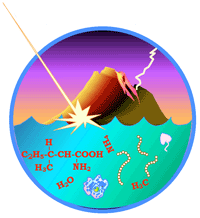
How Does Life Begin and Develop?
Goal
1
How
Life Arose on Earth
Goal
2
Organization of Matter into Living Systems
Goal
4
Coevolution of the Biosphere and the Earth
Does Life Exist Elsewhere in the Universe?
Goal
7
Signature of Life on Other Worlds
Goal
8
Life on Mars and Europa
What is Life's Future on Earth and Beyond?
Goal
9
Environmental Change on Earth
Goal
10
Terrestrial Life in Space
Question: How Does Life Begin and Develop?
Goal 1: Understand How Life Arose on Earth

Perform historical,
observational, and experimental investigations to understand the origin
of life on our planet, including the possibility that it arrived at Earth
from elsewhere.
Terrestrial life is the only form of life that we know, and it appears to have arisen from a common ancestor. How and where did this remarkable event occur? We can now perform historical, observational, and experimental investigations to understand the origin of life on our planet. We should determine the source of the raw materials of life, either produced on this planet or arriving from space. We should seek to understand in what environments the components may have assembled and what forces led to the development of systems capable of deriving energy from their surroundings and manufacturing copies of themselves. We should also investigate the exchange of biological materials between planets to assess the possibility that life formed elsewhere and subsequently migrated to Earth.
Background
For the prebiotic Earth, we seek to understand the origin and chemical nature of organic and inorganic compounds, and the energy sources and micro-environments that created the context for the origin of life. Given a plausible primary source of organic components, alternative pathways by which such prebiotic compounds formed the ancient counterparts of proteins, nucleic acids, and lipid-like molecules can be investigated within plausible constraints. One major objective is to construct laboratory models of assemblies of biopolymers recognizable as protocells. These will then be used to create models for the first microorganisms able to replicate and evolve on the early Earth, thereby leading to a common ancestry that is consistent with the later development of biological diversity. Another approach is to use the phylogenetic and geologic record to point to characteristics of our earliest ancestor. We should also consider the possibility that life formed elsewhere and was seeded onto the developing Earth; if so, we can ask under what conditions elsewhere life might have arisen and been transported to our planet. Understanding the interplanetary transportation and survivability of organisms is also relevant to issues surrounding possible contemporary exchange of biological material with Mars and hence the importance of quarantine of Mars samples returned to Earth. Theoretical calculation of mass transport rates, life on Earth in extreme environments (Goal 5), and further study of meteorites and collections of interstellar materials should allow significant progress in understanding whether these natural processes provide a mechanism for spreading life through the universe. This research is closely related to the issue of planetary habitability (Goal 6) and the general issue of the life principle (Goal 2).